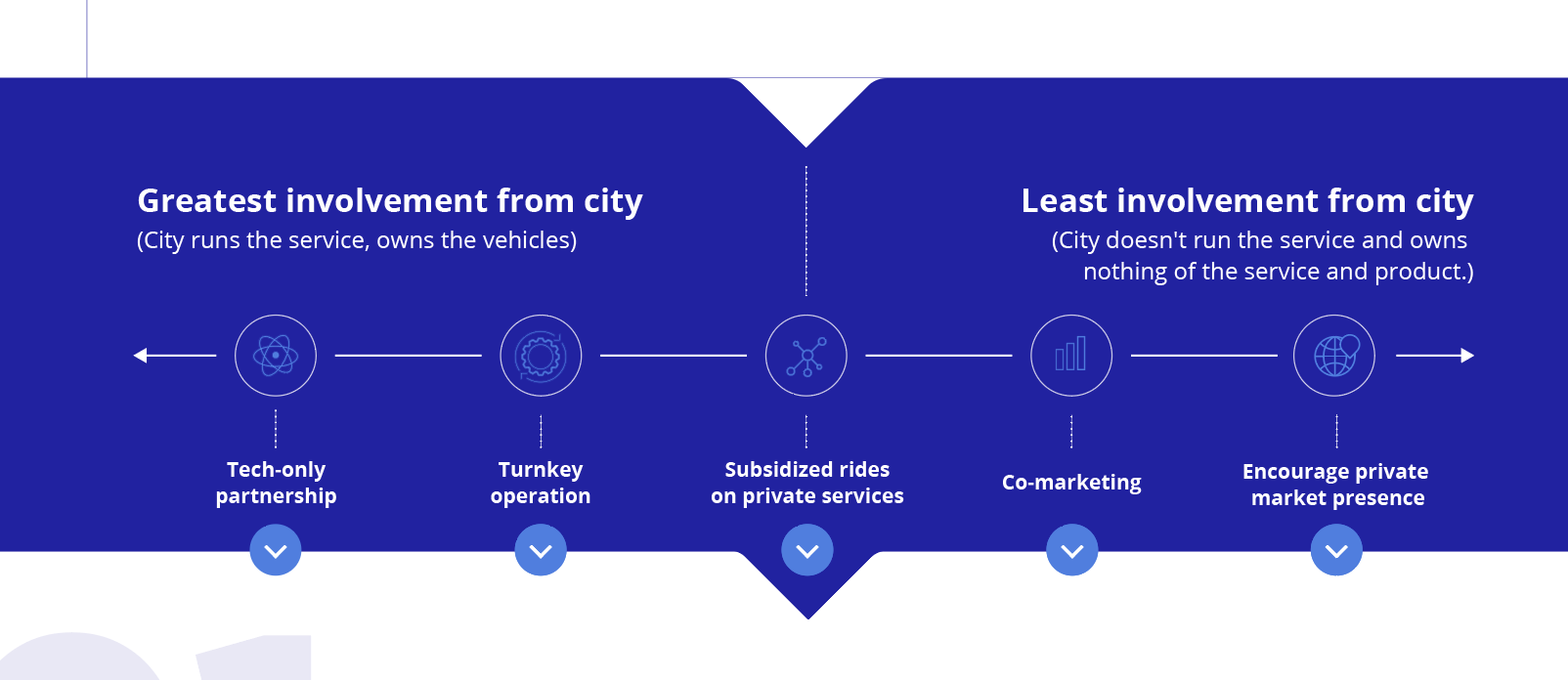

Collaboration between cities and new mobility providers fall along a spectrum of public/private engagement arrangements. Various options are briefly discussed in this handbook arranged from greatest levels
of city involvement and control to the most laissez-faire/private-sector dependent in which cities have little or no control over the private operator’s activities.





Greatest involvement from city
(City runs the service, owns the vehicles)
Least involvement from city
(City doesn't run the service neither owns the vehicles)




How it works:
The city uses a technology platform from a company to enhance their mobility solutions. This is a well known practice for combination of trip planning, reservations, payment, dispatch, and routing. Other aspects of operations remain the cities´ responsibility (including the provision of vehicles and drivers).
- Service may be marketed/co-branded as “powered by” tech provider, or white label with agency’s own branding.
- The most modest form is the development of customer-facing trip planning/tracking app for agency services.
- Priced monthly/annually after startup costs, based on the number of vehicles or users.
Advantages:
- The city keeps full control over the operation of the vehicles, and it is easier to regulate deployment in the city.
- Easier to either scale-up or downsize.
- Alignment with other city goals is easier to achieve.
Disadvantages:
- Resource intensive for the city since everything (e.g. vehicles, docking stations) would need to be purchased and managed (e.g. maintenance, incident support, monitoring)

Example:
The Bicing bike sharing system in Barcelona is managed and maintained by the city. Since 2019, the private company Cespa has been contracted by the municipality to provide the user application.



Tech-only partnership

Turnkey operation

Subsidized rides on private services

Co-marketing

Encourage private market presence

Back to
top



Example:
As part of the FABULOS project, which is piloting autonomous buses in Europe, one of the project partners is developing a turnkey transportation-as-a-service (TaaS) platform, combining both autonomous and human-driven vehicles. SAGA’s TaaS platform includes all aspects of launching a publicly accessible autonomous vehicle service, including service design, autonomous vehicle management, and fleet routing. Using this platform, multiple automated and human-driven vehicles can be integrated into a larger public transport system, all over an open API.
How it works:
The city contracts a single company or consortium that covers all aspects of launching and operating new tech-driven mobility services: operations planning, procurement of vehicles, hiring drivers & operations staff, technology deployment, vehicle operations and maintenance (possibly marketing & outreach as well).
- Generally, a company operates transparently under the city’s brand, through co-branding.
- Many companies offer both tech-only service (“software as a service”/SaaS) and full turnkey operation (“transportation as a service”/TaaS) to answer different needs and capacity levels among cities.
- Besides micro-mobility, many early deployments/pilot projects of Autonomous vehicles (AV) also follow this model.
Advantages:
- Also suitable for smaller cities, those with less staff capacity and don´t own existing solutions.
- A turnkey business often already has a proven successful business model and merely requires investment from the public sector.
- Stronger data reporting than more private-sector services (ride-hail especially), as operations are all under the agency’s contractual umbrella.
Disadvantages:
- The mobility provider designs and develops the solution, which minimizes the client's ability to control project details and interfere with the solution development.
Transportation as a service

Tech-only partnership

Turnkey operation

Subsidized rides on private services

Co-marketing

Encourage private market presence

Back to
top

Example:
The city of Paris is trying to encourage e-bike usage by subsidising both private purchase and subscriptions to the Veligo program. The latter allows residents to rent e-bikes long-term - for up to 6 months - at a rate of €40 a month, half of which can be covered by one's employer.


How it works:
Cities subsidize private rides that support public goals but have little commercial viability. This is used to avoid undercutting transit and is often focused on specific populations (e.g. low-income people without vehicle access) or specific applications:
- First/last mile solutions to dedicated areas (e.g. hospitals, university, business parks, etc.).
- People with disabilities or the elderly.
- Travel in suburbs/low-density areas where fixed-route transit can’t be productive.
- Late-night trips/travel at times/in areas where transit doesn’t run.
- Occasional, unexpected trips (guaranteed ride home), as part of a larger package of transportation services.
- There is a variety of subsidy structures with differing budget implications:
- Entire cost; up to a certain amount with customer covering the difference.
- The inverse; specific amount after initial fare.
Advantages:
- Taking advantage of the popularity & flexibility of ride-hail & taxis.
- Easy to set requirements to a provider.
- Great way to make sure shared mobility is also accessible for low-income households. By subsidising the mobility provider, the lower-income household can ride for a lower price.
- Makes it more attractive for mobility providers as it takes away some of their risk of operation.
Disadvantages:
- It can be hard measuring the success and to what degree the subsidies are helping.
- Requires financial involvement from the city
transportation services

Tech-only partnership

Turnkey operation

Subsidizing rides on private transport

Co-marketing

Encourage private market presence

Back to
top

Example:
TIER / Munich (Europe’s leading mico-mobility provider) partners with cities and local public transport providers so they can get e-scooters on the streets. The cities brand/market it as an eco-friendly last-mile solution and are often integrated into the urban MaaS applications.



How it works:
The city is mainly involved in engaging customers and making the private rides more attractive for the inhabitants through marketing and e.g. integrating it into a larger MaaS platform.
- Takes advantage of large crossover between transit & new mobility customer bases, mutually advantageous to link services in riders’ minds.
- Incorporating service info into trip planning apps.
- Promotion of discounts from mobility providers.
Advantages:
- Least demanding partnership approach from a city perspective.
- Shows the city´s commitment to innovation & attracting new riders and better serve current ones, while limiting risk.
- Little investment or risk beyond staff time.
Disadvantages:
- Increased chances of losing control over the mobility-provider and its operations.

Tech-only partnership

Turnkey operation

Subsidized rides on private services

Co-marketing

Encourage private market presence

Back to
top


Example:
One way to encourage private market presence while still keeping some control of what is happening is through licencing. This means that the city gives a mobility provider the permission to use public space for its operations if they comply to certain pre-established requirements. The city of Leuven is giving 2-3 year licences for mobility providers to operate. This is in order to give them certainty. However, if they do not comply with the pre-esablished requirements, they will not be allowed to operate anymore. Amongst the requirements in Leuven is that they cover the whole city (also less attractive areas), they have to prove a minimum service level and have a minimum standard of quality.
How it works:
The city uses its regulatory and policy power to encourage the presence of private services seen as worthwhile (and discourage bad behavior).
- The city uses control over public space (e.g. roads, curbs, parking) which private companies need to access.
- Areas near transit stations in dense downtowns are the greatest premium: access can be exchanged for commitment to serve less appealing areas.
Advantages:
- No public investment nor risk beyond staff time.
- Can help manage competition among private operators, encourage socially beneficial outcomes.
- Fleet operators (dockless micromobility) can qualify for higher fleet caps/lower fees through performance-based permitting (good behavior → higher caps)
Disadvantages:
- If the city does not put down any restrictions/requirements, one can be faced with an overload of suppliers.
- Since mobility is a low-profit business, a market without city intervention and support will be less attractive for mobility providers, especially start-ups with less financial security (it is risky for them).



Tech-only partnership

Turnkey operation

Subsidized rides on private services

Co-marketing

Encourage private market presence

Back to
top





Collaboration between cities and new mobility providers fall along a spectrum of public/private engagement arrangements. Various options are briefly discussed in this handbook arranged roughly from greatest levels of city involvement and control to the most laissez-faire/private-sector dependent in which cities have little or no control over the private operator’s activities (as well as the least risk and financial responsibility).
Greatest involvement from city
(City runs the service, owns the vehicles)
Least involvement from city
(City doesn't run the service and owns nothing of the service and product.)






How it works:
The city uses a technology platform from a company to enhance their mobility solutions. This is a well known practice for combination of trip planning, reservations, payment, dispatch, and routing. Other aspects of operations remain the cities´ responsibility (including the provision of vehicles and drivers).
- Service may be marketed/co-branded as “powered by” tech provider, or white label with agency’s own branding.
- The most modest form is the development of customer-facing trip planning/tracking app for agency services.
- Priced monthly/annually after startup costs, based on the number of vehicles or users.
Advantages:
- The city keeps full control over the operation of the vehicles, and it is easier to regulate deployment in the city.
- Easier to either scale-up or downsize.
- Alignment with other city goals is easier to achieve.
Disadvantages:
- Resource intensive for the city since everything (e.g. vehicles, docking stations) would need to be purchased and managed (e.g. maintenance, incident support, monitoring)

Example:
The Bicing bike sharing system in Barcelona is managed and maintained by the city. Since 2019, the private company Cespa has been contracted by the municipality to provide the user application.



How it works:
The city contracts a single company or consortium that covers all aspects of launching and operating new tech-driven mobility services: operations planning, procurement of vehicles, hiring drivers & operations staff, technology deployment, vehicle operations and maintenance (possibly marketing & outreach as well).
- Generally, a company operates transparently under the city’s brand, through co-branding.
- Many companies offer both tech-only service (“software as a service”/SaaS) and full turnkey operation (“transportation as a service”/TaaS) to answer different needs and capacity levels among cities.
- Besides micro-mobility, many early deployments/pilot projects of Autonomous vehicles (AV) also follow this model.
Advantages:
- Also suitable for smaller cities, those with less staff capacity and don´t own existing solutions.
- A turnkey business often already has a proven successful business model and merely requires investment from the public sector.
- Stronger data reporting than more private-sector services (ride-hail especially), as operations are all under the agency’s contractual umbrella.
Disadvantages:
- The mobility provider designs and develops the solution, which minimizes the client's ability to control project details and interfere with the solution development.
Transportation as a service



Example:
As part of the FABULOS project, which is piloting autonomous buses in Europe, one of the project partners is developing a turnkey transportation-as-a-service (TaaS) platform, combining both autonomous and human-driven vehicles. SAGA’s TaaS platform includes all aspects of launching a publicly accessible autonomous vehicle service, including service design, autonomous vehicle management, and fleet routing. Using this platform, multiple automated and human-driven vehicles can be integrated into a larger public transport system, all over an open API.
How it works:
Cities subsidize private rides that support public goals but have little commercial viability. This is used to avoid undercutting transit and is often focused on specific populations (e.g. low-income people without vehicle access) or specific applications:
- First/last mile solutions to dedicated areas (e.g. hospitals, university, business parks, etc.).
- People with disabilities or the elderly.
- Travel in suburbs/low-density areas where fixed-route transit can’t be productive.
- Late-night trips/travel at times/in areas where transit doesn’t run.
- Occasional, unexpected trips (guaranteed ride home), as part of a larger package of transportation services.
- There is a variety of subsidy structures with differing budget implications:
- Entire cost; up to a certain amount with customer covering the difference.
- The inverse; specific amount after initial fare.
Advantages:
- Taking advantage of the popularity & flexibility of ride-hail & taxis.
- Easy to set requirements to a provider.
- Great way to make sure shared mobility is also accessible for low-income households. By subsidising the mobility provider, the lower-income household can ride for a lower price.
- Makes it more attractive for mobility providers as it takes away some of their risk of operation.
Disadvantages:
- It can be hard measuring the success and to what degree the subsidies are helping.
- Requires financial involvement from the city

Example:
The city of Paris is trying to encourage e-bike usage by subsidising both private purchase and subscriptions to the Veligo program. The latter allows residents to rent e-bikes long-term - for up to 6 months - at a rate of €40 a month, half of which can be covered by one's employer.


How it works:
The city is mainly involved in engaging customers and making the private rides more attractive for the inhabitants through marketing and e.g. integrating it into a larger MaaS platform.
- Takes advantage of large crossover between transit & new mobility customer bases, mutually advantageous to link services in riders’ minds.
- Incorporating service info into trip planning apps.
- Promotion of discounts from mobility providers.
Advantages:
- Least demanding partnership approach from a city perspective.
- Shows the city´s commitment to innovation & attracting new riders and better serve current ones, while limiting risk.
- Little investment or risk beyond staff time.
Disadvantages:
- Increased chances of losing control over the mobility-provider and its operations.

Example:
TIER / Munich (Europe’s leading mico-mobility provider) partners with cities and local public transport providers so they can get e-scooters on the streets. The cities brand/market it as an eco-friendly last-mile solution and are often integrated into the urban MaaS applications.



How it works:
The city uses its regulatory and policy power to encourage the presence of private services seen as worthwhile (and discourage bad behavior).
- The city uses control over public space (e.g. roads, curbs, parking) which private companies need to access.
- Areas near transit stations in dense downtowns are the greatest premium: access can be exchanged for commitment to serve less appealing areas.
Advantages:
- No public investment nor risk beyond staff time.
- Can help manage competition among private operators, encourage socially beneficial outcomes.
- Fleet operators (dockless micromobility) can qualify for higher fleet caps/lower fees through performance-based permitting (good behavior → higher caps)
Disadvantages:
- If the city does not put down any restrictions/requirements, one can be faced with an overload of suppliers.
- Since mobility is a low-profit business, a market without city intervention and support will be less attractive for mobility providers, especially start-ups with less financial security (it is risky for them).

Example:
One way to encourage private market presence while still keeping some control of what is happening is through licencing. This means that the city gives a mobility provider the permission to use public space for its operations if they comply to certain pre-established requirements. The city of Leuven is giving 2-3 year licences for mobility providers to operate. This is in order to give them certainty. However, if they do not comply with the pre-esablished requirements, they will not be allowed to operate anymore. Amongst the requirements in Leuven is that they cover the whole city (also less attractive areas), they have to prove a minimum service level and have a minimum standard of quality.




